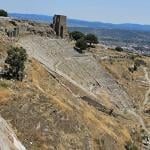Orangutans, gorillas, flamingos and red-ruffed lemurs acted strangely before humans detected the historic magnitude-5.8 earthquake. Now the question hovering over the zoo is: What did the animals know, and when did they know it?
Therein lies a scientific mystery, one in which hard facts and solid observations are entangled with lore and legend. There has been talk over the years about mysterious electromagnetic fields generated by rupturing faults. There has been speculation about sounds inaudible to humans, and subtle tilting in rock formations, and the release of vapors that people can’t smell.But there also may be less to the mystery than meets the eye, with Tuesday’s zoo weirdness merely serving as a reminder that many wild animals are paying close attention to nature while humans are doing whatever it is that humans do.
The zoo documented a broad range of animal behavior before, during and after the tremor that began in central Virginia and shook much of the eastern United States. For example, a gorilla, Mandara, shrieked and grabbed her baby, Kibibi, racing to the top of a climbing structure just seconds before the ground began to shake dramatically. Two other apes — an orangutan, Kyle, and a gorilla, Kojo — already had dropped their food and skedaddled to higher turf.
The 64 flamingos seemed to sense the tumult a number of seconds in advance as well, clustering together in a nervous huddle before the quake hit. One of the zoo’s elephants made a low-pitched noise as if to communicate with two other elephants.
And red-ruffed lemurs emitted an alarm cry a full 15 minutes before the temblor, the zoo said.
During the quake, the zoo grounds were filled with howls and cries. The snakes, normally inert in the middle of the day, writhed and slithered. Beavers stood on their hind legs and then jumped into a pond. Murphy the Komodo dragon ran for cover. Lions resting outside suddenly stood up and stared at their building as the walls shook.
Damai, a Sumatran tiger, leaped as if startled but quickly settled down. Some animals remained agitated for the rest of the day, wouldn’t eat and didn’t go to sleep on their usual schedule. . . .
The belief that strange animal behavior is a precursor to earthquakes goes back to antiquity. A recent scientific study suggested that toads fled to higher ground days before the 2009 earthquake in L’Aquila, Italy. In the most famous case of modern times, snakes and frogs emerged from their holes in 1975 in the dead of winter several weeks before a magnitude-7.3 earthquake in Haicheng, China (the odd animal behavior helped persuade officials to evacuate the city just before the tremor).
via Zoo mystery: How did apes and birds know quake was coming? – The Washington Post.
One explanation has to do with the so-called p-wave, a faint foreshock that precedes the big s-wave in an earthquake. This is imperceptible to human beings, but maybe animals can pick it up. The p-wave hit 15 seconds before the big 5.8-on-the-Richter-scale shock. That would explain some of the animal behavior. But some of the zoo animals started panicking a full 15 minutes before the quake.











